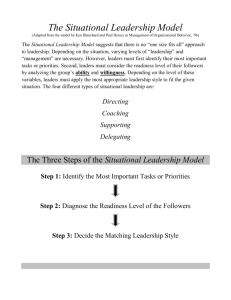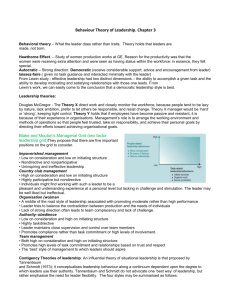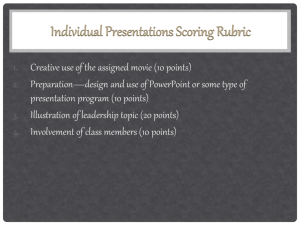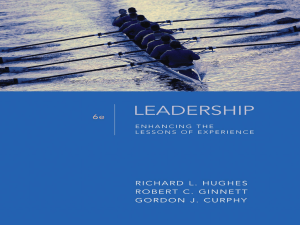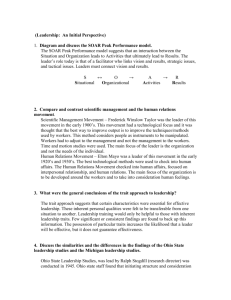CHAPTER 2 Leadership Behavior and Processes
advertisement
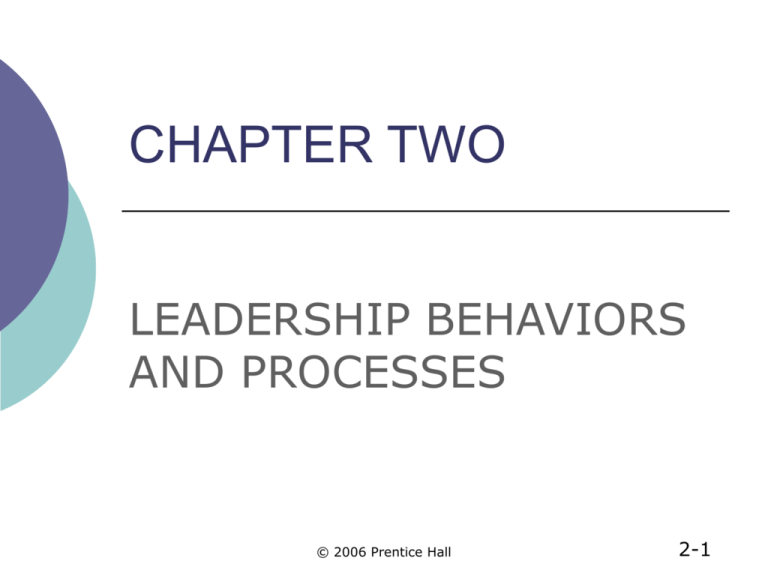
CHAPTER TWO LEADERSHIP BEHAVIORS AND PROCESSES © 2006 Prentice Hall 2-1 Learning Objectives After reading this chapter, you should be able to do the following: Describe patterns of behavior that leaders frequently exhibit. Identify the effects of specific leader behaviors on followers' psychological reactions and performance. Discuss the impact of situational and follower characteristics on leader effectiveness. © 2006 Prentice Hall 2-2 Learning Objectives (cont.) After reading this chapter, you should be able to do the following: Explain how leaders can utilize specific types of situational and follower characteristics to increase their effectiveness. Describe the sources of power and influence tactics often used by leaders. Describe the Leadership Process Model for influencing followers’ behavior. © 2006 Prentice Hall 2-3 Core Behavior Patterns of Leaders DIRECTIVE Assigns followers specific tasks, explains methods, clarifies expectations, sets goals, and specifies procedures. SUPPORTIVE Shows consideration, acceptance, and concern for the needs and feelings of followers. REWARD & PUNISHMENT Provides intrinsic and extrinsic benefits. Punishes for unwanted follower behaviors. BEHAVIOR PATTERNS OF LEADERS © 2006 Prentice Hall PARTICIPATIVE Involves followers in making decisions by consulting to get suggestions and ideas. CHARISMATIC Displays high expectations, confidence & competence. Communicates vision with ideological goals which reflect follower needs. 2-4 Supportive Leadership Behavior This behavior pattern refers to the leader’s role in showing concern for the comfort and well-being of followers; demonstrating a considerate, kind, and understanding attitude in dealing with followers; being friendly and informative; and encouraging open two-way communication and follower development. Familiar terms associated with supportive leadership are consideration, relationship-orientation, or concern for people leadership. © 2006 Prentice Hall 2-5 Directive Leadership Behavior This pattern refers to the leader’s behaviors in assigning followers to specific tasks, explaining the methods to be used in completing the tasks, clarifying expectations regarding quantity and quality of follower performance, setting goals for followers, planning and coordinating followers’ work, and specifying rules and procedures to be followed. This behavior pattern has also been known as or is closely related to initiating structure, instrumental leadership, or taskoriented leadership. © 2006 Prentice Hall 2-6 Participative Leadership Behavior The leader who uses this approach involves followers in the decision-making include holding one-on-one meetings with individuals or groups of followers to gather input for decisions; it may involve a group decision-making effort initiated by the leader; or it may involve assigning a particular problem to a follower to resolve. Each of these options represents different degrees or types of processes. Participative leader behaviors may participative leader behavior. Participative leadership is sometimes referred to as consultative, democratic, or delegatory leadership. © 2006 Prentice Hall 2-7 Leader Reward and Punishment Behavior With this leader behavior, when followers provide services to the organization, the leader rewards them with tangible and intangible benefits. The rewards may be monetary, or they may consist of praise. Punishments may come in the form of a reduction in pay or a notice to the follower that work needs improvement. Rewards and punishments may be provided based on follower performance (contingently) or based on the leader’s whim (noncontingently). Rewards and punishments based on performance are usually the most effective. © 2006 Prentice Hall 2-8 Charismatic Leadership Behavior This pattern of behavior involves the leader communicating a vision of the future that has ideological significance to followers (often through use of powerful imagery and metaphors), arousing follower needs which are relevant to goal accomplishment, serving as a role model, expressing high expectations and confidence in followers’ capabilities, and projecting a high degree of self-confidence. © 2006 Prentice Hall 2-9 Leadership Model for Influencing Follower Behaviors LEADER BEHAVIORS FOLLOWERS/GROUP PSYCHOLOGICAL REACTIONS Perceptions Attitudes Feelings Motivations Expectations FOLLOWER BEHAVIORAL OUTCOMES Performance Absenteeism Turnover © 2006 Prentice Hall 2-10 Leadership Model Applied to Eisenhower’s Leader Behavior LEADER BEHAVIORS Eisenhower’s participative leader behaviors encouraged and allowed other generals to present and defend their position on military strategies. PSYCHOLOGICAL REACTIONS of Other Generals Feelings of involvement and influence Commitment to the decision process and decision outcomes Satisfaction with the process and the resulting decisions BEHAVIORAL OUTCOMES High effort Cooperation Effective military strategies High performance © 2006 Prentice Hall 2-11 Factors That Influence Leader Effectiveness LEADER CHARACTERISTICS behaviors traits and skills sources of power SITUATIONAL CHARACTERISTICS task group organizational FOLLOWER CHARACTERISTICS abilities and skills attitudes and values needs and motivations © 2006 Prentice Hall 2-12 Situational Factors that Enhance Leadership Effectiveness Leadership enhancers are situational or follower characteristics that increase the leader's influence on followers Cohesive work groups with strong norms to cooperate with leaders enhance participative leadership. Stressful, dangerous, or dissatisfying job tasks enhance supportive leadership. A large number of followers enhance directive leadership. © 2006 Prentice Hall 2-13 Situational Factors that Neutralize Leadership Effectiveness Leadership neutralizers are situational or follower characteristics that can decrease the effectiveness of the leader's influence on followers A large spatial/geographic distance between leaders and followers inhibits leaders from effectively directing followers. Organizational reward systems based on seniority, union contracts, or civil service policies prevent leaders from adequately rewarding the best performers. Senior managers who countermand or modify effective directions by a lower-level manager prevent leaders from having the influence that is needed. © 2006 Prentice Hall 2-14 Situational Factors that Substitute for Leadership Behaviors Some characteristics of followers, their work tasks, or the organization can provide task guidance and incentives to such an extent that they substitute for certain leader behaviors Followers' training and experience may substitute for directive leadership. Intrinsically satisfying work tasks may substitute for supportive leadership. Networked computer systems and computer integrated manufacturing may for directive leadership © 2006 Prentice Hall 2-15 Power, Influence, and Authority Power - the ability of one person to cause another person to do something. Influence - the use of power or power in action. Authority - Authority is a specific type of power. An individual has authority if she has a legitimate right to require another person to do something, usually because the individual with authority holds a certain position. © 2006 Prentice Hall 2-16 Types of Power Person Based Power: Position Based Power: Expert Power—leader has special knowledge. Referent Power—followers admire or identify with the leader. Legitimate Power—the leader has the right to make requests. Position and/or Person Based Power: Reward Power—followers comply to obtain rewards. Coercive Power—followers comply to avoid punishments. Connection/Resource Power—leader provides needed resources or relationships. © 2006 Prentice Hall 2-17 Leadership Process Model for Influencing Follower Behaviors LEADER BEHAVIORS SITUATIONAL FACTORS THAT INCREASE LEADER EFFECTIVENESS Enhancers of Leader Behavior Follower characteristics & situational characteristics which increase leaders’ direct influence Factors that Substitute for Leadership Follower characteristics & situational characteristics that replace the need for leadership by influencing psychological reactions and behavioral outcomes FOLLOWER/GROUP PSYCHOLOGICAL REACTIONS Perceptions Attitudes Feelings Motivations Expectations SITUATIONAL FACTORS THAT DECREASE LEADER EFFECTIVENESS Neutralizers of Leader Behavior Follower characteristics & situational characteristics which decrease leaders’ direct influence FOLLOWER BEHAVIORAL OUTCOMES Performance Absenteeism Turnover © 2006 Prentice Hall 2-18



